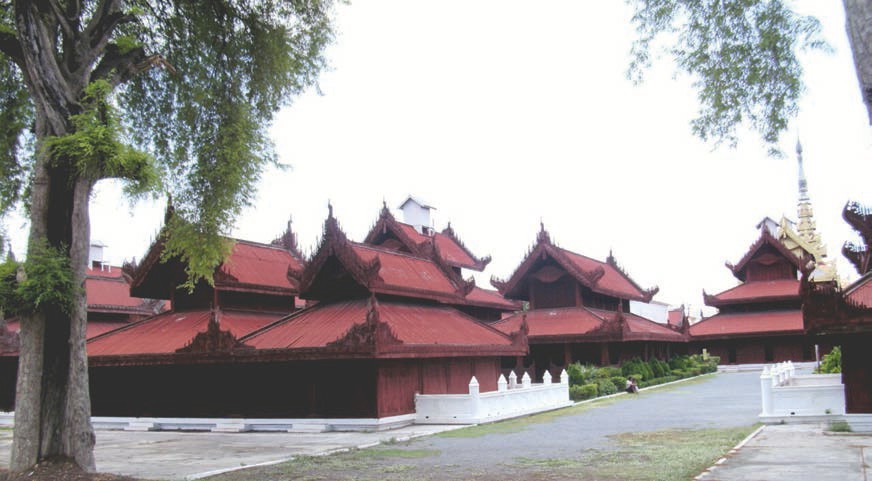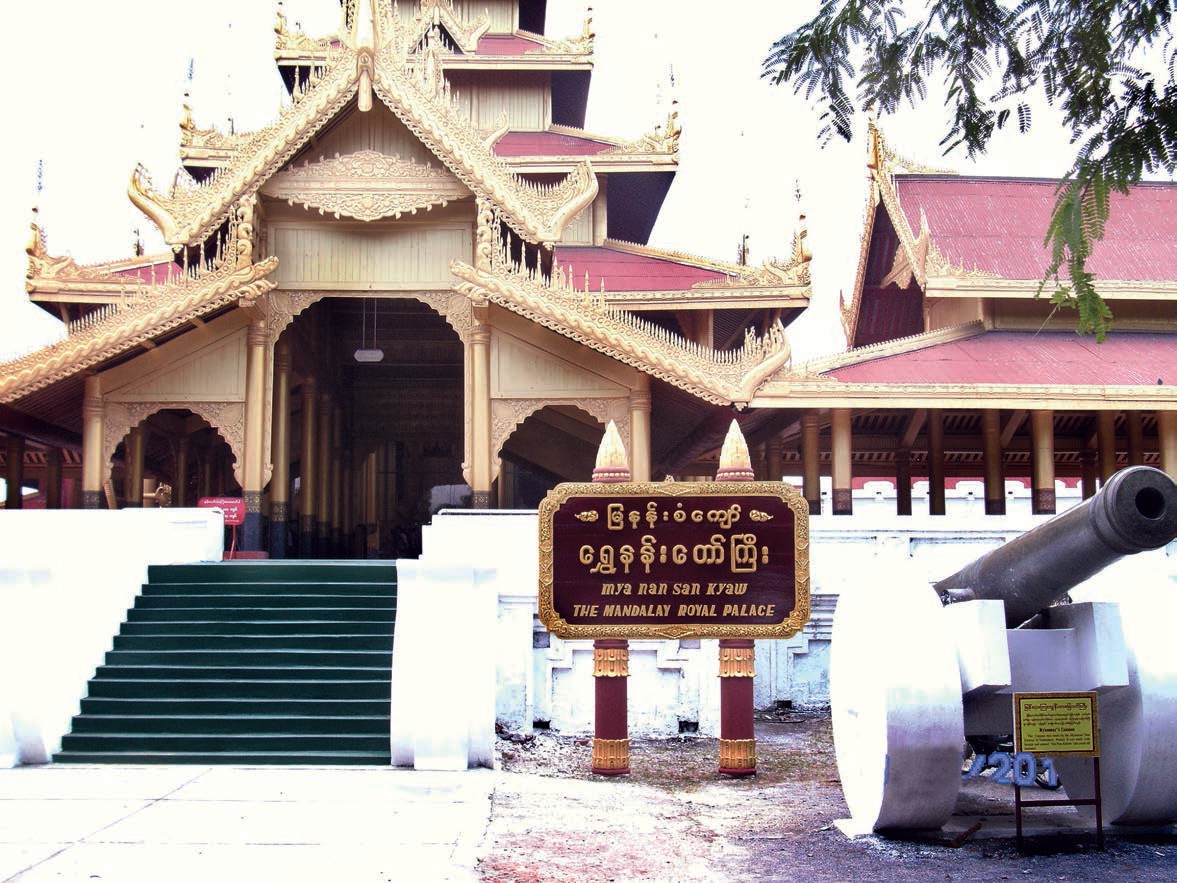19 OCTOBER 2019
THOSE who have visited Mandalay royal city could see Myanansankyaw Golden Palace built in the royal city and could take pride of royal traditions and buildings of Myanmar. Royal buildings including Myanansankyaw Golden Palace where two kings of Yadanabon era resided in late Konbaung era before Myanmar lost its independence are heritages to foster patriotic spirit of Myanmar.
Myanansankyaw Golden Palace is one of the cultural heritages of royal Myanmar. As architectural works of Myanmar royal palace and various kinds of culture are collectively showcased, homegrown and international tourists observe these items on a daily basis.
King Thayawady called King Shwebo (1837-1846 AD) came onto the throne in Inwa. One year later, he established Amarapura City and moved his throne there. In 1840, Amarapura Royal Palace was completed. King Thayawady named the royal palace as Aungmyesanya, and the golden palace tier-roofed building as Shwenansantha. King Bagan and King Mindon also resided at the golden palace. However, King Mindon resided at Amarapura in 1853, and four years later, he established new city Yadanabon.

New Yadanabon City which would be renowned as Mandalay was rounded with the border embankment in the east, Ayeyawady River in the west, Dokhtawady River in the south and Madaya River in the north. The area among them was selected by King Mindon himself. The land preparation for the royal palace started on 12th waxing of Nadaw, 1219 Myanmar Era (27 November 1857), Friday.
On 16 July 1858 when Yadanabon Royal City and Royal Palace had been built, King Mindon and the First Queen entered the Royal Palace through Myay NandawOo Stairs by jewellery palanquin. The same day, the white elephant captured by Thaungthut chieftain arrived at the royal city by the raft.
Before the reign of King Mindon, respective thrones were positioned at relevant buildings of the Golden Palace. Although there were eight kinds of thrones, the palace had two Thihathana Thrones. That was why number of thrones at the palace hit nine. Thihathana Thrones were placed at the ground tier-roofed building and the royal court respectively. Although some records mentioned that all nine thrones were built in the reign of King Bodawphaya, vet- eran historian Dr Than Tun wrote that all kinds of thrones were built with the use of golden and silver construction equipment on 7 May 1858 at the same time.
The Golden Palace established by King Mindon was formed with 32 royal halls in the east, four royal halls and 78 halls for queens at different levels in the west, totalling 114. The king named the royal city as Laykyun Aungmye and the golden palace as Myanansankyaw.

The brick building of Nanmyint hall, King Thibaw brick building, Taungpankhontaw brick building, and western ceremonial halls from the western royal halls were built in the reign of King Thibaw. He dissolved the royal golden hall where his father King Mindon passed away, close to the glass hall, and rebuilt it as the golden palace monastery at the foot of Mandalay Hill dedicating to his father.
Yadanabon City was fenced with walls which were 5.03 miles long in total. The city was formed with 144 “Pya” plots, 16 plots of which were built by the royal palace and 128 plots of which were resided by princes, counselors and wealthy persons. Local people lived in remaining 54 plots. Veteran historian Dr Than Tun wrote that walls of the royal city from the east to the west was one mile and two furlongs long and from the north to the south, two furlongs and 88 yards long.
The golden palace built on the 11 feet high brick structure was 1,004 feet long from the east to the west and 574 feet wide from the north to the south. The golden palace was fenced with log walls and 27 feet high brick walls. Each side of the walls had three gates, so there were 12 gates at four sides of the walls.
Three royal ladders were installed for the king and the first queen on the front wing of the golden palace. The east Samok hall was located for princes and staff of the palace to attend the royal conference at the foot of the ladders. The ground Sanu hall was located between the ground tier-roofed hall and the east Samok hall. At the royal conference, the left general, the right general, and chieftains paid respects to the king. The east Samok hall was between the left and right ground ceremonial halls.
The ground tier-roofed hall, west of the ground Sanu hall, was a significant hall with seven tiers and 207 feet in height. Thihathana throne was placed in the centre of the hall. The whole hall was gilt. Both king and first queen accepted respects paid by followers in the early year, before and after the Buddhist lent.
Zetawun Hall in design of the facility in the time of the Lord Buddha was built west of the ground tier-roofed hall. Hanthathana throne was placed in Zetawun Hall, Gazathana throne in Byetaik Hall, Thinkhathana throne in Laytha Hall, Migathana throne in South Samok Hall, Mayurathana throne in North Samok Hall, Padumathana throne in West Zetawun Hall and Bamayathana throne in the glass hall.
Titles of the royal halls were named with essence, and the thrones were decorated with significant artistic works. These thrones were placed in respective halls and the king and the first queen took positions.
Yadanabon-Mandalay city lasted for 28 years from 27 November 1857 to 28 November 1885 due to occupation of colonialists. Consequently, the royal palace became firewood. In the Second World War, various buildings of the royal palace were burnt in bomb blasts. The golden palace monastery built by King Thibaw at the foot of Mandalay Hill remains unchanged in original works.
In recent decades, the government decided to rebuild Myanansankyaw Golden Palace in the ancient style during the reign of King Thibaw in accordance with the records from palm leaves, English-Myanmar records and historical documents to be able to show the firm documents of possessing independence and sovereignty of Myanmar’s kings.
The cornerstones were laid for royal heritages Myanansankyaw Golden Palace on 8 December 1989. It was rebuilt with four tier-roofed buildings at the corners of the walls and Laythein Gate on the northern wall and Oohteik Gate on the eastern wall with seven tiers roofed buildings. A total of 35 damaged tier-roofed structures in wars were rebuilt on 48 ‘PyaOh’ positions on the walls.
Myanansankyaw Golden Palace rebuilt in original style was inaugurated on a grand scale in conjunction with Maha Atulawaiyan (Atumashi Monastery) at the foot of Mandalay Hill on 18 September 1996. Currently, the Nanmyint Tower hall, the eastern halls and the western halls for queens at different levels can be seen in Myanansankyaw Golden Palace in original style. Visitors may enjoy the aerial view of the royal city from Nanmyint Tower.
The cultural museum of the Department of Archaeology and National Museum opened at Myanansankyaw Golden Palace showcases records in Yadanabon era, royal equipment, royal regalia and documentary photos. Thanks to Myanansankyaw Golden Palace, Myanmar people will embrace the spirit of adoring cultural heritages.
Translated by Than Tun Aung
Reference:
Myanmar Encyclopaedia Year Book (1995) Royal Palace built with fences of plots (Natmauk Tun Shein) Dates History of Myanmar, Konbaung era (U Tikkhadhammalankara and Dr Than Tun)


